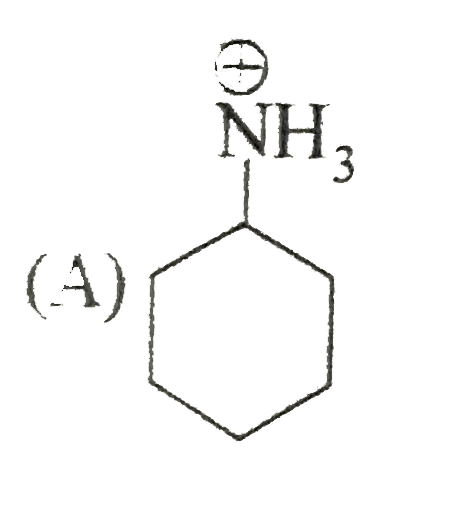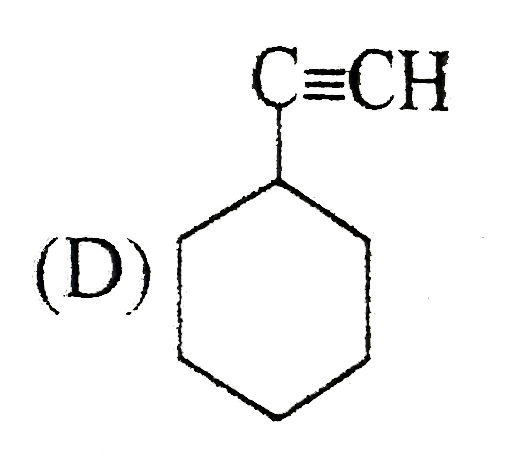Which of the following is lowest pKa value?




The correct Answer is:A
To determine which of the given compounds has the lowest pKa value, we need to analyze the acidity of each compound. The lower the pKa value, the stronger the acid, meaning it can donate a proton (H⁺) more readily.
1. Identify the Compounds:
We have four compounds to consider:
- Ammonia (NH₃)
- Hydroxide (OH⁻)
- Amide (NH₂⁻)
- Terminal Alkyne (C≡CH)
2. Understand Acidity:
The acidity of a compound is determined by its ability to donate a proton (H⁺). The more stable the conjugate base formed after deprotonation, the stronger the acid and the lower the pKa value.
3. Analyze Each Compound:
- Ammonia (NH₃): When NH₃ donates a proton, it forms NH₂⁻. The pKa of NH₃ is approximately 36.
- Hydroxide (OH⁻): This is a strong base and does not typically donate a proton in the context of acidity. Its pKa is very high, indicating low acidity.
- Amide (NH₂⁻): When NH₂⁻ donates a proton, it forms NH₃. The pKa is also high, around 38.
- Terminal Alkyne (C≡CH): When a terminal alkyne donates a proton, it forms a carbanion (C≡C⁻). The pKa of terminal alkynes is around 25, indicating they are more acidic than NH₃ and NH₂⁻.
4. Compare pKa Values:
- NH₃: pKa ≈ 36
- OH⁻: Very high pKa
- NH₂⁻: pKa ≈ 38
- C≡CH: pKa ≈ 25
5. Conclusion:
Among the compounds analyzed, the terminal alkyne (C≡CH) has the lowest pKa value of approximately 25, making it the strongest acid in this list.
Final Answer:
The compound with the lowest pKa value is C≡CH (Terminal Alkyne).
We have four compounds to consider:
- Ammonia (NH₃)
- Hydroxide (OH⁻)
- Amide (NH₂⁻)
- Terminal Alkyne (C≡CH)
The acidity of a compound is determined by its ability to donate a proton (H⁺). The more stable the conjugate base formed after deprotonation, the stronger the acid and the lower the pKa value.
- Ammonia (NH₃): When NH₃ donates a proton, it forms NH₂⁻. The pKa of NH₃ is approximately 36.
- Hydroxide (OH⁻): This is a strong base and does not typically donate a proton in the context of acidity. Its pKa is very high, indicating low acidity.
- Amide (NH₂⁻): When NH₂⁻ donates a proton, it forms NH₃. The pKa is also high, around 38.
- Terminal Alkyne (C≡CH): When a terminal alkyne donates a proton, it forms a carbanion (C≡C⁻). The pKa of terminal alkynes is around 25, indicating they are more acidic than NH₃ and NH₂⁻.
- NH₃: pKa ≈ 36
- OH⁻: Very high pKa
- NH₂⁻: pKa ≈ 38
- C≡CH: pKa ≈ 25
Among the compounds analyzed, the terminal alkyne (C≡CH) has the lowest pKa value of approximately 25, making it the strongest acid in this list.
The compound with the lowest pKa value is C≡CH (Terminal Alkyne).
Topper's Solved these Questions
- GENERAL ORGANIC CHEMISTRYBook:BANSALChapter:GENERAL ORGANIC CHEMISTRYExercise:Exercise 2
Explore 38 Videos
- GENERAL ORGANIC CHEMISTRYBook:BANSALChapter:GENERAL ORGANIC CHEMISTRYExercise:Exercise 3
Explore 19 Videos
- GENERAL ORGANIC CHEMISTRYBook:BANSALChapter:GENERAL ORGANIC CHEMISTRYExercise:Exercise 3
Explore 19 Videos
- D AND F BLOCK ELEMENTSBook:BANSALChapter:D AND F BLOCK ELEMENTSExercise:EXERCISE-4 (SECTION-B)
Explore 7 Videos
- NITROGEN COMPOUNDSBook:BANSALChapter:NITROGEN COMPOUNDSExercise:EXERCISE-4 (Section-4) SECTION -B( JEE Main Previous Question )
Explore 5 Videos
Similar Questions
Knowledge Check
Which of the following has more pKa value ?
A B
B C
C D
D
Which of the following has lowest kb value ?
ABenzenamineBN-methyl anilineCN,N-dimethyl anilineDN, N- dimethyl methamineWhich of the following has lowest pKa value ?
A B
B C
C D
D
Among the following which has lowest pKa value?
View SolutionWhich of the following has highest Pka value ?
View SolutionWhich of the following will have lowest value of pKb?
View SolutionWhich of the following will have lowest value of pKb?
View SolutionWhich of the following has the lowest pKa value?
View Solution

